
The Decapoda or decapods are an order of crustaceans within the class Malacostraca, and includes crabs, lobsters, crayfish, shrimp, and prawns. Most decapods are scavengers. The order is estimated to contain nearly 15,000 extant species in around 2,700 genera, with around 3,300 fossil species. Nearly half of these species are crabs, with the shrimp and Anomura including hermit crabs, porcelain crabs, squat lobsters making up the bulk of the remainder. The earliest fossils of the group date to the Devonian.

The tiger pistol shrimp belongs to the Alpheidae family, known commonly as snapping shrimp.

Hippolytidae is a family of cleaner shrimp, also known as broken-back shrimp or anemone shrimp. The term "broken-back shrimp" also applies to the genus Hippolyte in particular and "cleaner shrimp" is sometimes applied exclusively to Lysmata amboinensis.
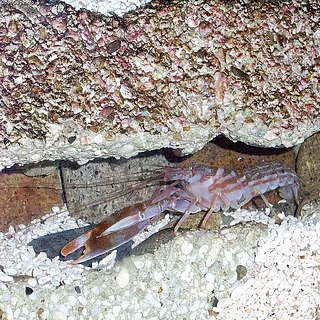
Alpheidae is a family within the infraorder caridea characterized by having asymmetrical claws, the larger of which is typically capable of producing a loud snapping sound.

Penaeidae is a family of marine crustaceans in the suborder Dendrobranchiata, which are often referred to as penaeid shrimp or penaeid prawns. The Penaeidae contain many species of economic importance, such as the tiger prawn, whiteleg shrimp, Atlantic white shrimp, and Indian prawn. Many prawns are the subject of commercial fishery, and farming, both in marine settings, and in freshwater farms. Lateral line–like sense organs on the antennae have been reported in some species of Penaeidae. At 210 metres per second (760 km/h), the myelinated giant interneurons of pelagic penaeid shrimp have the world record for impulse conduction speed in any animal.

Alpheus is a genus of snapping shrimp of the family Alpheidae. This genus contains in excess of 330 species, making this the most species-rich genus of shrimp. Like other snapping shrimp, the claws of Alpheus are asymmetrical, with one of the claws enlarged for making a popping noise. Some species in the genus enter into symbiotic relationships with gobiid fishes, and others associate with sea anemones.

Potamalpheops is a genus of shrimp in the family Alpheidae. It was originally erected by Powell in 1979 to house species from Africa. Later, Horton H. Hobbs, Jr. realised that the troglobitic shrimp he had described in 1973 from Oaxaca, Mexico as Alpheopsis stygicola, also belonged to the genus, and in 1991, A. J. Bruce described a new species from Australia, further expanding the genus' geographical range. It is now thought to represent a relict taxon from the Tethys Sea.

Salmoneus is a genus of shrimps of the family Alpheidae. Understanding of the genus has grown rapidly, with only 19 known species before 2000, to 69 species as of 2024.
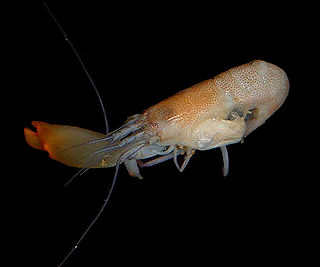
Synalpheus is a genus of snapping shrimp of the family Alpheidae, presently containing more than 160 species; new ones are described on a regular basis, and the exact number even of described species is disputed.
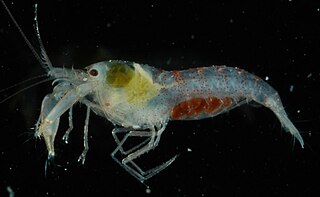
Metabetaeus is a genus of shrimp in the family Alpheidae, comprising four species:

Alpheus rapacida is a species of snapping shrimp of the family Alpheidae. It is found at depths of up to 56 metres (184 ft) across the Indo-West Pacific, with a few recent observations from the Mediterranean coasts of Israel and Turkey as a Lessepsian migrant.

Petrolisthes is a genus of marine porcelain crabs, containing these extant species:

Palaemonidae is a family of shrimp in the order Decapoda. Many species are carnivores that eat small invertebrates, and can be found in any aquatic habitat except the deep sea. One significant genus is Macrobrachium, which contains commercially fished species. Others inhabit coral reefs, where they associate with certain invertebrates, such as sponges, cnidarians, mollusks, and echinoderms, as cleaner shrimps, parasites, or commensals. They generally feed on detritus, though some are carnivores and hunt tiny animals.
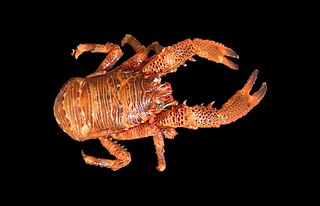
Galathea is a genus of squat lobsters in the family Galatheidae. It is one of the largest genera of squat lobsters that in 2008 contained 73 species. Most species of Galathea live in shallow waters.

Actumnus is a genus of crabs in the family Pilumnidae. Alongside the 28 extant species, it has a fossil record extending back into the Miocene.
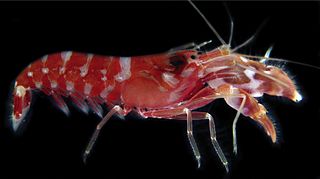
Alpheoidea is a superfamily of shrimp. Species of shrimp in the superfamily Alpheoidea are drag swimmers, as opposed to lift swimmers.

Campylonotoidea is a superfamily of shrimp, containing the two families Campylonotidae and Bathypalaemonellidae. Fenner A. Chace considered it to be the sister group to the much larger superfamily Palaemonoidea, with which it shares the absence of endopods on the pereiopods, and the fact that the first pereiopod is thinner than the second. Using molecular phylogenetics, Bracken et al. proposed that Campylonotoidea may be closer to Atyoidea. There are sixteen described species in 3 genera; no fossils are known.

Marsupenaeus is a monotypic genus of prawn. It contains a single species, Marsupenaeus japonicus, known as the kuruma shrimp, kuruma prawn, or Japanese tiger prawn. It occurs naturally in bays and seas of the Indo-West Pacific, but has also reached the Mediterranean Sea as a Lessepsian migrant. It is one of the largest species of prawns, and is accordingly one of the most economically important species in the family.

Periclimenaeus is a genus of decapod crustaceans of the family Palaemonidae which is part of the infraorder Caridea. The genus was named by the English carcinologist Lancelot Alexander Borradaile in 1915. He set out the distinguishing features of the genus as:
Body rather stout, cephalothorax deep, a good deal compressed, abdomen greatly curved Thorax without dorsal swelling. Rostrum rather short, compressed, toothed above only. Outer antennular flagellum not deeply cleft. Antennal scale of good breadth. Mandible without palp. Second maxilliped without podopalp. Third maxilliped narrow, with vestigial arthrobranch.

Leptochela is a genus of small, shallow-water shrimp from the family Pasiphaeidae. They are found in the Indo-Pacific region and the western Atlantic with an isolated species in Hawaii, they are absent from the eastern Atlantic Ocean and were absent from the eastern Pacific but specimens of a species widespread in the western Atlantic were collected from waters to the south of the tip of Baja California. Two species, Leptochela aculeocaudata and Leptochela pugnax have invaded the eastern Mediterranean from the Red Sea through the Suez Canal and are thus classified as Lessepsian migrants.


















